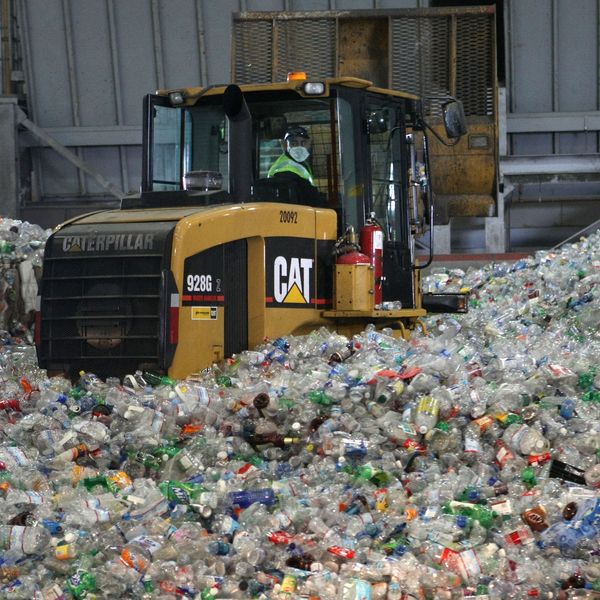
A scientist observes microplastics in a lab.
70+ US Lawmakers Demand EPA Boost Regulation of Microplastic Pollution
"As plastic pollution saturates our planet and our bodies, the Biden administration should take every reasonable step to protect our environment and public health," said Rep. Lloyd Doggett.
Citing extensive research which has shown recently that microplastics are ubiquitous in the environment, more than 70 U.S. House members on Friday wrote to the Environmental Protection Agency to demand stronger regulation of the microscopic particles that are used in everyday household items and have been linked to respiratory diseases and cancers.
Rep. Lloyd Doggett (D-Texas) led lawmakers including Reps. Pramila Jayapal (D-Wash.), Mark Pocan (D-Wis.), and Barbara Lee (D-Calif.) in writing the letter, which notes that under the Clean Water Act, the EPA can and should "use its existing statutory authorities to address the growing prevalence of microplastic pollution" across the country.
Currently, the lawmakers said, it is largely being left up to individual states to decide whether to regulate microplastics, leading to "troubling disparities... regarding basic protections."
In Doggett's home state, the Texas Commission on Environmental Quality last year "quickly abandoned" a proposal to require "chemical companies to have internal processes restricting accidental releases of plastic pollution," while California residents are benefiting from a statewide effort led by the California Ocean Protection Council to reduce microplastics in marine environments.
"Federal action should encourage high standards to mitigate microplastics in natural environments, which can ultimately make their way into the food we eat, the water we drink, and the air we breathe," wrote the lawmakers.
\u201cAs plastic pollution saturates our planet and our bodies, the Biden Administration should take every reasonable step to protect our environment and public health.\n\nToday, I led more than 70 Members in urging the @EPA to strengthen its regulation of microplastic pollution.\u201d— Lloyd Doggett (@Lloyd Doggett) 1683901323
The letter points to a 2020 study which found that scientists discovered microplastic pollution in some of the world's most remote places, including Mount Everest, and research from 2021 which suggested the average adult ingests 320,000 microplastics each year.
As Common Dreams reported last year, a team of researchers in the U.K. found tiny microplastic particles lodged in the lungs of 11 out of 13 patients at a hospital, with the most common microplastic found being polypropylene—commonly used in plastic packaging, textiles, and kitchen utensils.
A draft report on microfiber pollution from the EPA and the National Oceanic and Atmospheric Administration (NOAA) found that microplastics "have the potential to impact human reproductive, respiratory, digestive, nervous, and urinary systems," noted Doggett and the other lawmakers on Friday.
"Plastic pollution is not just affecting our oceans and marine life—it's flowing in our bloodstreams and lingering on nearly every object we touch," said Doggett in a statement. "Regulating microplastics as hazardous waste will protect our health and our environment."
The lawmakers wrote that they are "encouraged" by the EPA and NOAA's draft report and accompanying federal plan for preventing microfiber pollution, but called on the agency to take steps under the Clean Water Act—whose "whole purpose is to eliminate the discharge of pollutants into our waters"—to mitigate microplastics in the environment.
The letter calls on EPA Administrator Michael Regan to:
- Issue national drinking water regulations for microplastics modeled on proposed rules for per-and polyfluoroalkyl substances (PFAS), using the Safe Drinking Water Act regulatory process to establish enforceable limits on the number of microplastics in water;
- Officially recognize microplastics as hazardous and toxic materials, rather than solid waste, so they can be regulated under the Resource Conservation and Recovery Act;
- Establish effluent limitations for industrial and general stormwater runoff to contain zero microplastic;
- Publish the final version of the EPA/NOAA joint report on microfiber pollution and pursue the recommended actions with an urgent timeline; and
- Increase research and outreach within the EPA's Trash Free Waters program to improve our understanding of microplastics
"These are actions that the EPA can and must take now," said Brandon, "to address this growing threat."
An Urgent Message From Our Co-Founder
Dear Common Dreams reader, The U.S. is on a fast track to authoritarianism like nothing I've ever seen. Meanwhile, corporate news outlets are utterly capitulating to Trump, twisting their coverage to avoid drawing his ire while lining up to stuff cash in his pockets. That's why I believe that Common Dreams is doing the best and most consequential reporting that we've ever done. Our small but mighty team is a progressive reporting powerhouse, covering the news every day that the corporate media never will. Our mission has always been simple: To inform. To inspire. And to ignite change for the common good. Now here's the key piece that I want all our readers to understand: None of this would be possible without your financial support. That's not just some fundraising cliche. It's the absolute and literal truth. We don't accept corporate advertising and never will. We don't have a paywall because we don't think people should be blocked from critical news based on their ability to pay. Everything we do is funded by the donations of readers like you. Will you donate now to help power the nonprofit, independent reporting of Common Dreams? Thank you for being a vital member of our community. Together, we can keep independent journalism alive when it’s needed most. - Craig Brown, Co-founder |
Citing extensive research which has shown recently that microplastics are ubiquitous in the environment, more than 70 U.S. House members on Friday wrote to the Environmental Protection Agency to demand stronger regulation of the microscopic particles that are used in everyday household items and have been linked to respiratory diseases and cancers.
Rep. Lloyd Doggett (D-Texas) led lawmakers including Reps. Pramila Jayapal (D-Wash.), Mark Pocan (D-Wis.), and Barbara Lee (D-Calif.) in writing the letter, which notes that under the Clean Water Act, the EPA can and should "use its existing statutory authorities to address the growing prevalence of microplastic pollution" across the country.
Currently, the lawmakers said, it is largely being left up to individual states to decide whether to regulate microplastics, leading to "troubling disparities... regarding basic protections."
In Doggett's home state, the Texas Commission on Environmental Quality last year "quickly abandoned" a proposal to require "chemical companies to have internal processes restricting accidental releases of plastic pollution," while California residents are benefiting from a statewide effort led by the California Ocean Protection Council to reduce microplastics in marine environments.
"Federal action should encourage high standards to mitigate microplastics in natural environments, which can ultimately make their way into the food we eat, the water we drink, and the air we breathe," wrote the lawmakers.
\u201cAs plastic pollution saturates our planet and our bodies, the Biden Administration should take every reasonable step to protect our environment and public health.\n\nToday, I led more than 70 Members in urging the @EPA to strengthen its regulation of microplastic pollution.\u201d— Lloyd Doggett (@Lloyd Doggett) 1683901323
The letter points to a 2020 study which found that scientists discovered microplastic pollution in some of the world's most remote places, including Mount Everest, and research from 2021 which suggested the average adult ingests 320,000 microplastics each year.
As Common Dreams reported last year, a team of researchers in the U.K. found tiny microplastic particles lodged in the lungs of 11 out of 13 patients at a hospital, with the most common microplastic found being polypropylene—commonly used in plastic packaging, textiles, and kitchen utensils.
A draft report on microfiber pollution from the EPA and the National Oceanic and Atmospheric Administration (NOAA) found that microplastics "have the potential to impact human reproductive, respiratory, digestive, nervous, and urinary systems," noted Doggett and the other lawmakers on Friday.
"Plastic pollution is not just affecting our oceans and marine life—it's flowing in our bloodstreams and lingering on nearly every object we touch," said Doggett in a statement. "Regulating microplastics as hazardous waste will protect our health and our environment."
The lawmakers wrote that they are "encouraged" by the EPA and NOAA's draft report and accompanying federal plan for preventing microfiber pollution, but called on the agency to take steps under the Clean Water Act—whose "whole purpose is to eliminate the discharge of pollutants into our waters"—to mitigate microplastics in the environment.
The letter calls on EPA Administrator Michael Regan to:
- Issue national drinking water regulations for microplastics modeled on proposed rules for per-and polyfluoroalkyl substances (PFAS), using the Safe Drinking Water Act regulatory process to establish enforceable limits on the number of microplastics in water;
- Officially recognize microplastics as hazardous and toxic materials, rather than solid waste, so they can be regulated under the Resource Conservation and Recovery Act;
- Establish effluent limitations for industrial and general stormwater runoff to contain zero microplastic;
- Publish the final version of the EPA/NOAA joint report on microfiber pollution and pursue the recommended actions with an urgent timeline; and
- Increase research and outreach within the EPA's Trash Free Waters program to improve our understanding of microplastics
"These are actions that the EPA can and must take now," said Brandon, "to address this growing threat."
Citing extensive research which has shown recently that microplastics are ubiquitous in the environment, more than 70 U.S. House members on Friday wrote to the Environmental Protection Agency to demand stronger regulation of the microscopic particles that are used in everyday household items and have been linked to respiratory diseases and cancers.
Rep. Lloyd Doggett (D-Texas) led lawmakers including Reps. Pramila Jayapal (D-Wash.), Mark Pocan (D-Wis.), and Barbara Lee (D-Calif.) in writing the letter, which notes that under the Clean Water Act, the EPA can and should "use its existing statutory authorities to address the growing prevalence of microplastic pollution" across the country.
Currently, the lawmakers said, it is largely being left up to individual states to decide whether to regulate microplastics, leading to "troubling disparities... regarding basic protections."
In Doggett's home state, the Texas Commission on Environmental Quality last year "quickly abandoned" a proposal to require "chemical companies to have internal processes restricting accidental releases of plastic pollution," while California residents are benefiting from a statewide effort led by the California Ocean Protection Council to reduce microplastics in marine environments.
"Federal action should encourage high standards to mitigate microplastics in natural environments, which can ultimately make their way into the food we eat, the water we drink, and the air we breathe," wrote the lawmakers.
\u201cAs plastic pollution saturates our planet and our bodies, the Biden Administration should take every reasonable step to protect our environment and public health.\n\nToday, I led more than 70 Members in urging the @EPA to strengthen its regulation of microplastic pollution.\u201d— Lloyd Doggett (@Lloyd Doggett) 1683901323
The letter points to a 2020 study which found that scientists discovered microplastic pollution in some of the world's most remote places, including Mount Everest, and research from 2021 which suggested the average adult ingests 320,000 microplastics each year.
As Common Dreams reported last year, a team of researchers in the U.K. found tiny microplastic particles lodged in the lungs of 11 out of 13 patients at a hospital, with the most common microplastic found being polypropylene—commonly used in plastic packaging, textiles, and kitchen utensils.
A draft report on microfiber pollution from the EPA and the National Oceanic and Atmospheric Administration (NOAA) found that microplastics "have the potential to impact human reproductive, respiratory, digestive, nervous, and urinary systems," noted Doggett and the other lawmakers on Friday.
"Plastic pollution is not just affecting our oceans and marine life—it's flowing in our bloodstreams and lingering on nearly every object we touch," said Doggett in a statement. "Regulating microplastics as hazardous waste will protect our health and our environment."
The lawmakers wrote that they are "encouraged" by the EPA and NOAA's draft report and accompanying federal plan for preventing microfiber pollution, but called on the agency to take steps under the Clean Water Act—whose "whole purpose is to eliminate the discharge of pollutants into our waters"—to mitigate microplastics in the environment.
The letter calls on EPA Administrator Michael Regan to:
- Issue national drinking water regulations for microplastics modeled on proposed rules for per-and polyfluoroalkyl substances (PFAS), using the Safe Drinking Water Act regulatory process to establish enforceable limits on the number of microplastics in water;
- Officially recognize microplastics as hazardous and toxic materials, rather than solid waste, so they can be regulated under the Resource Conservation and Recovery Act;
- Establish effluent limitations for industrial and general stormwater runoff to contain zero microplastic;
- Publish the final version of the EPA/NOAA joint report on microfiber pollution and pursue the recommended actions with an urgent timeline; and
- Increase research and outreach within the EPA's Trash Free Waters program to improve our understanding of microplastics
"These are actions that the EPA can and must take now," said Brandon, "to address this growing threat."

